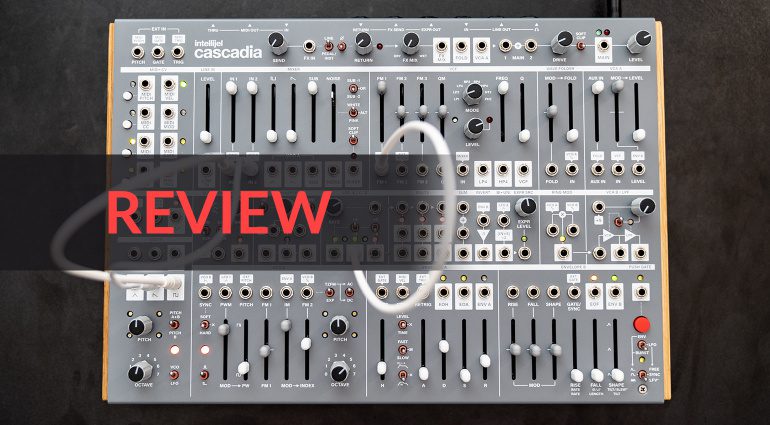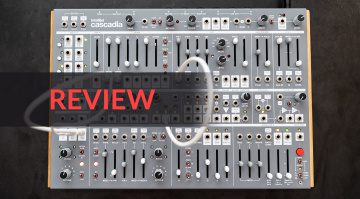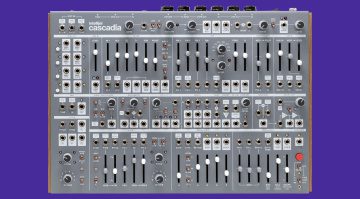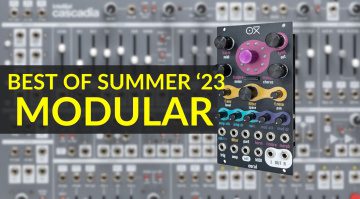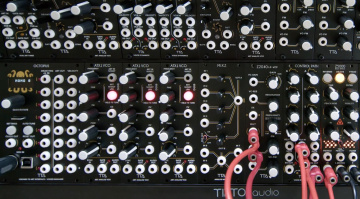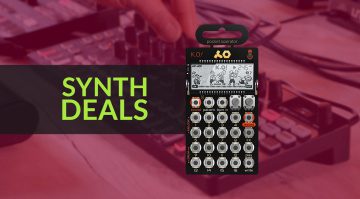Intellijel Cascadia: On Sale & Reviewed
West Coast meets East Coast and so much more...
[13 November 2024] Today Intellijel is celebrating its 15th anniversary – Happy Birthday! – with a special promotion of its popular semi-modular synthesizer Cascadia. Since its foundation, Intellijel has definitely earned its place in the synthesizer community and is appreciated by many artists worldwide for its innovative Eurorack modules and synthesizers. And not without reason!
15 Years of Intellijel and an Interesting Offer
To celebrate this milestone, Intellijel is offering a limited time price promotion for Cascadia as part of its 15th anniversary and is offering the synthesizer here at Thomann.de (affiliate) for $1,739.00 / £1,650.00 / 1,949.00€ instead of 2,218.00€. This anniversary promotion marks the beginning of a series of special releases that will be announced throughout the year. We are very excited about what is to come! If you want to know more about the synthesizer, you can read our review below.

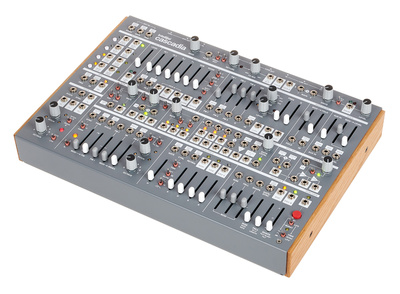
All About Intellijel Cascadia
Intellijel Cascadia: semi-modular synthesizer – our review!
[07 June 2023] Intellijel Cascadia is a pleasantly small semi-modular desktop synth. It’s loaded with features to create just about any sound imaginable. The compact device is almost a whole modular system in itself. With a very solid build and a high-quality user interface added. We check out Cascadia’s sound and workflow, as well as its integration into a studio environment, in this review.
Intellijel Cascadia – Highlights
- Compact form factor
- Semi-modular / modular
- Loaded with features and utilities
- Pre-patched signal path for instant plug and play
- Enormous amount of possibilities for sound designers
- send/return for external effects
Cascadia – a synth for everyone?
Are you West Coast or East Coast? Or just making music, designing sounds, not caring about a thing? Looking for the ultimate sound design synth for every sound in your head and beyond? Then Intellijel Cascadia should definitely be on your list. Because this little beast of a semi-modular synth brings just so many features to the table. If you’re just starting out on all things synth, you can do just that with the Cascadia. Because the signal path has been preconfigured in a way that you don’t need to do any patching. And synth heads will be astonished again and again. Because this thing is a complete modular system that can lead you into many different synthesis worlds.
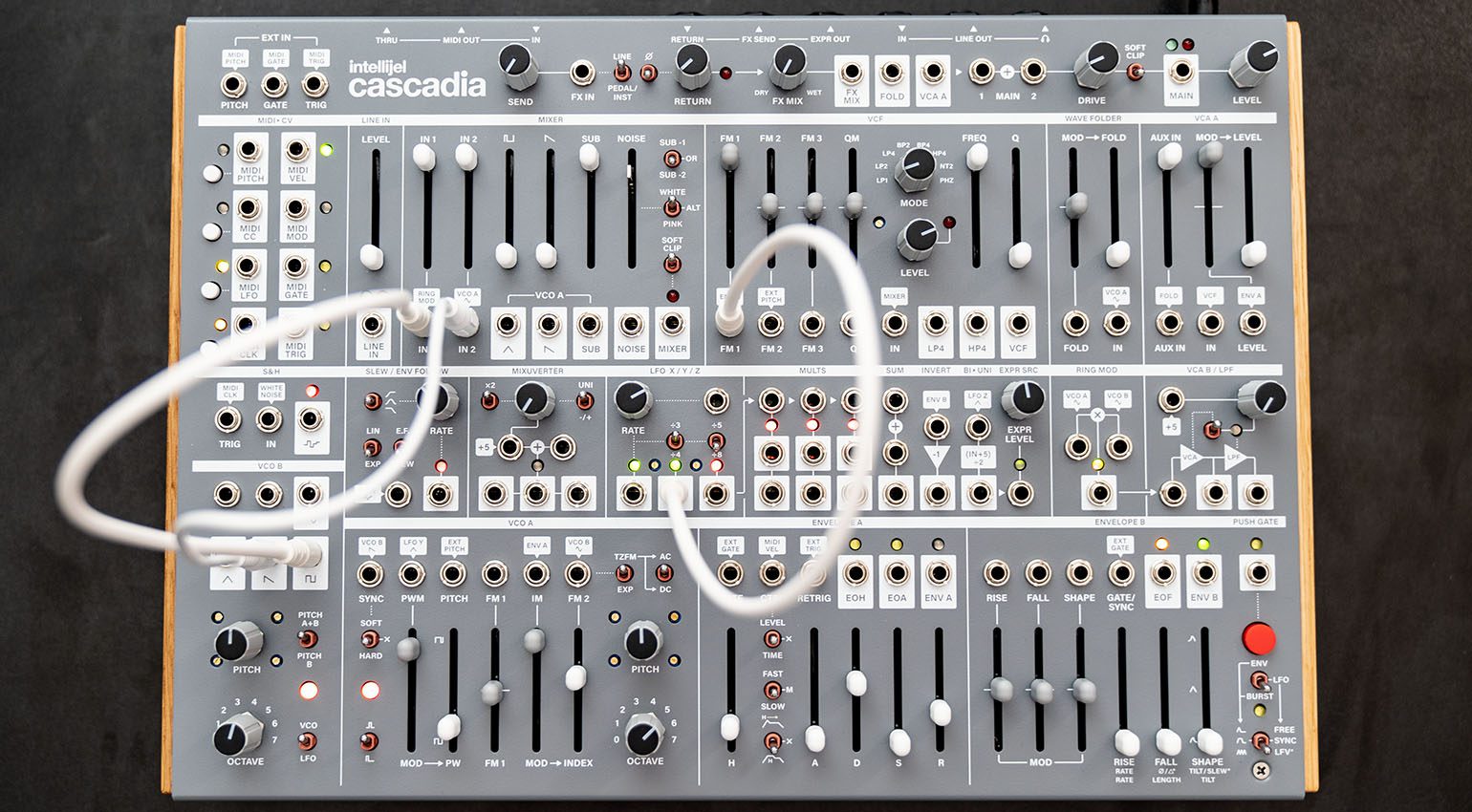
But what does the new Cascadia sound like? And how deeply can i integrate it into my studio workflow with all of my other synths, sequencers, and drum machines? I examined all of this in my sound lab. Thanks to Intellijel for lending a unit for this review!
Unboxing Intellijel Cascadia
Unboxing Intellijel Cascadia is a rather bland affair. There is the surprisingly small instrument, an external power supply, a bag of patch cables and a USB-cable. After my initial surprise about Cascadia’s size, I took quite a liking to it. Such a small form factor is actually an advantage in today’s loaded studios and on crowded stage tables. Nice!

A closer look at the hardware
Despite its small size, Cascadia feels bigger. Every fader and knob (and there are plenty) worked without a hitch. That’s how it should be! Everything feels extremely high-grade, which is to be expected for a price of about 2.000 Euros. As is usual, all the connectivity (USB, MIDI I/O, Audio I/O, power supply) happens on the back, while the actual playing and mangling happens on top.
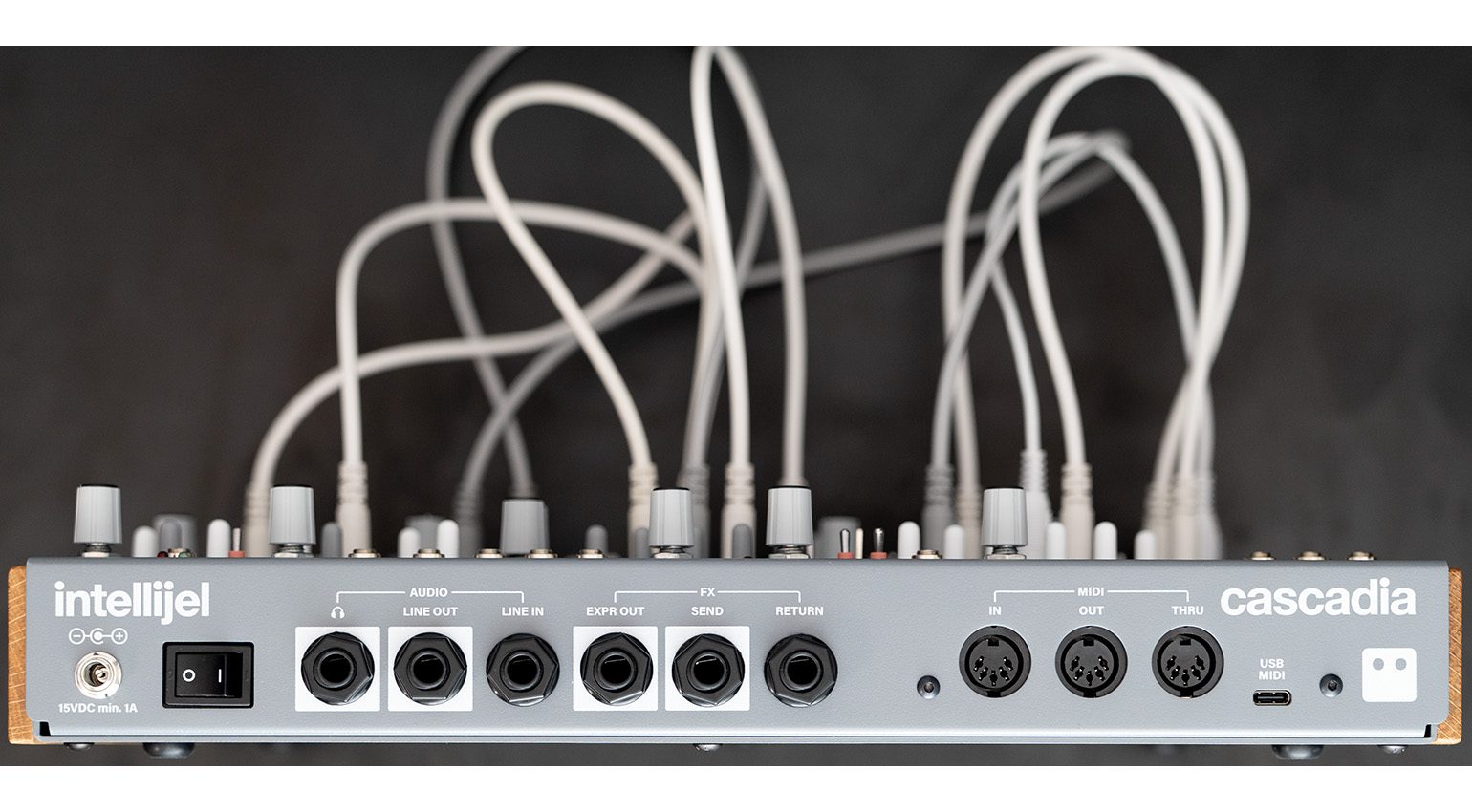
Cascadia sits sturdily on my studio desk and doesn’t move an inch while I’m working the sliders and knobs. The patch inputs’ build seems very solid as well so they’ll happily endure constant plugging and abrupt unplugging for years to come. The knobs seem very sturdy and their feel while turning them is “expensive”. There are wooden panels on each side which really make the look of the whole thing.
Intellijel Cascadia is a sound designer’s dream
Once connected, Cascadia starts blinking immediately. Just send the box a couple of MIDI notes, and it turns them into sound without any patching. The structure of the user interface is very straight-forward and logical so most will find their way pretty quickly. In the upper left corner, you’ll find the mixer for the five waveforms (2x Ins, Square, Saw, Sub) with an added noise generator. Next to this is the filter section (low pass, high pass, band pass, notch, and phazor), followed by the wavefolder and the VCA.
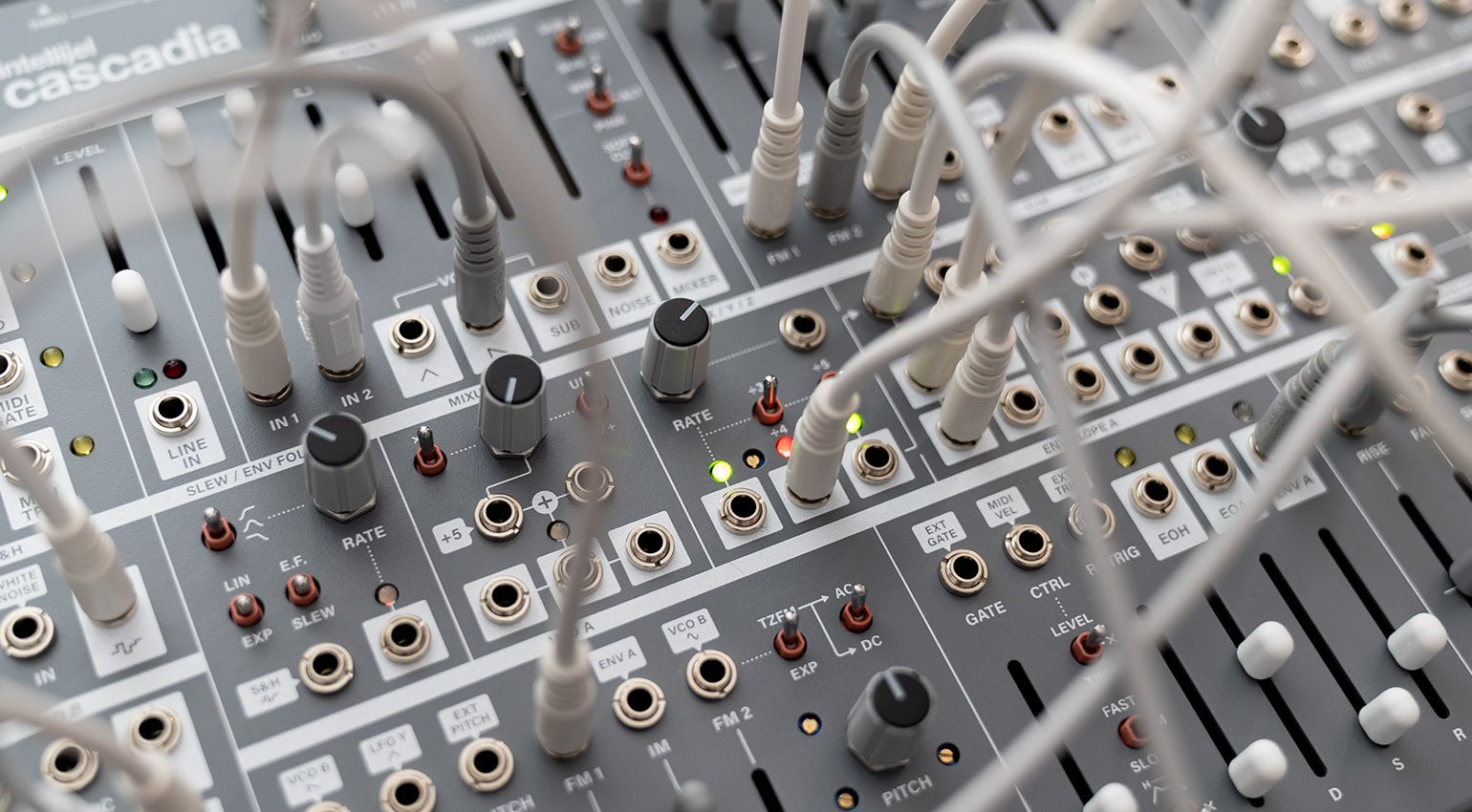
Underneath sits the modulation section which or more than well equips. There are envelope generators, LFOs, a variety of utility modulators, and settings for the two VCOs. VCO B can be used as a regular oscillator or an LFO interchangeably. Above the mixer of the five oscillators you get a top row with inputs for CV Pitch, Gate, Trigger as well as effects. There are also controls for sends level, drive (including Soft Clip), and a knob for the master volume. Here, you can also connect both external effects and additional audio sources (line or effects pedals). You get to choose between mini-jack and jack inputs, which is a big plus.
Cascadia in the studio
Since every input and output on the Intellijel Cascadia is Eurorack-compatible, the synth integrates rather smoothly into a pre-existing modular rack. Which can extend Cascadia’s sound palette quite a bit, depending on the modules you combine it with. Besides that, Intellijel also went a step further on the MIDI-side of things. You can not only send the synth MIDI notes and sync it. Cascadia can also receive MIDI CC modulation, so you can basically automate many of its parameters! A simply learn function connects a CC value with the respective control on the hardware controller. In addition, you can change and adapt this configuration with the free Config App (Windows download / Mac download).
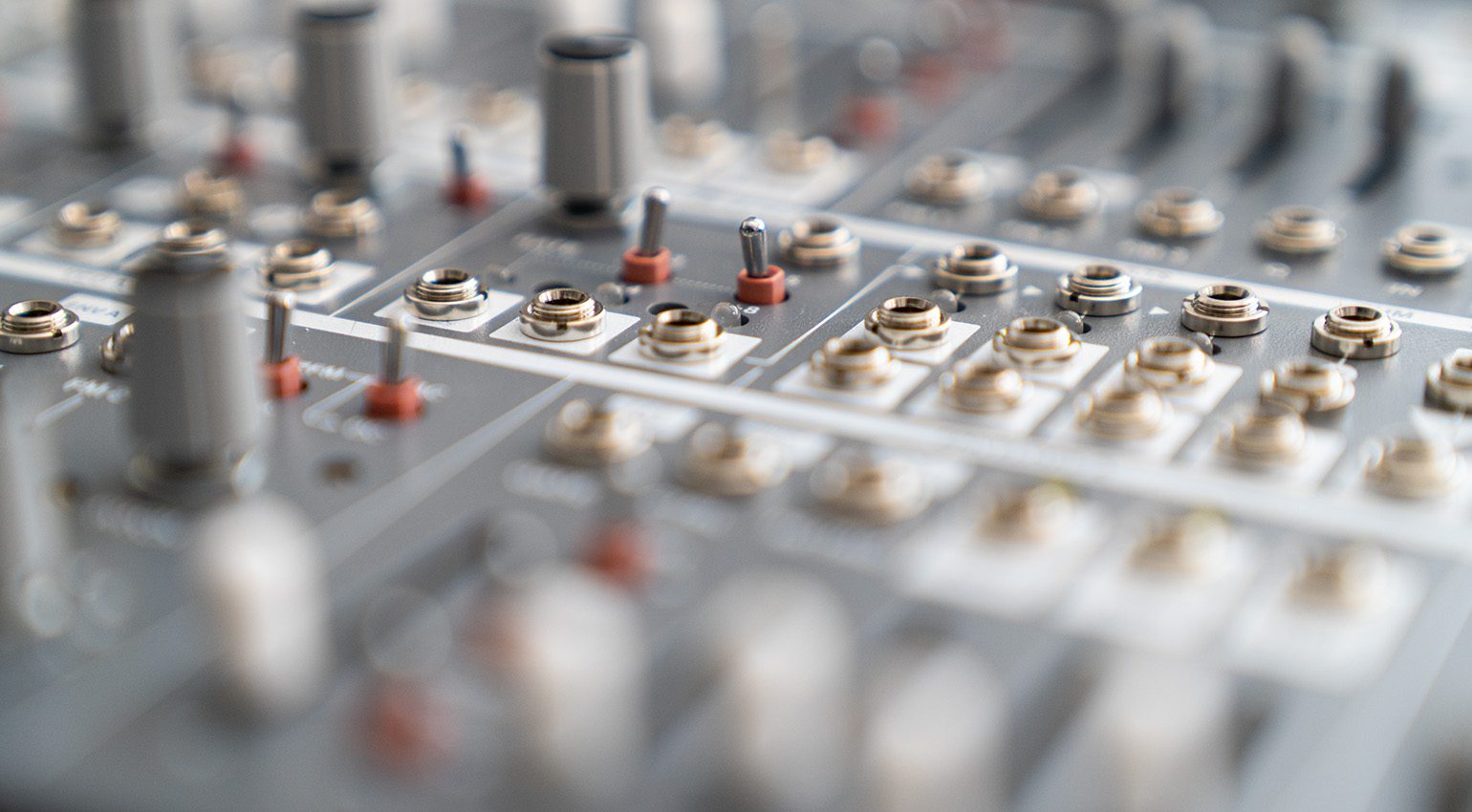
You can also use Cascada as a MIDI-to-CV interface, which is quite an interesting feature. All incoming MIDI signals can directly be routed from eight patch outputs on the synth at its top. And from here you can send them to just about anywhere on the synth, but also to other modules or semi-modulars.
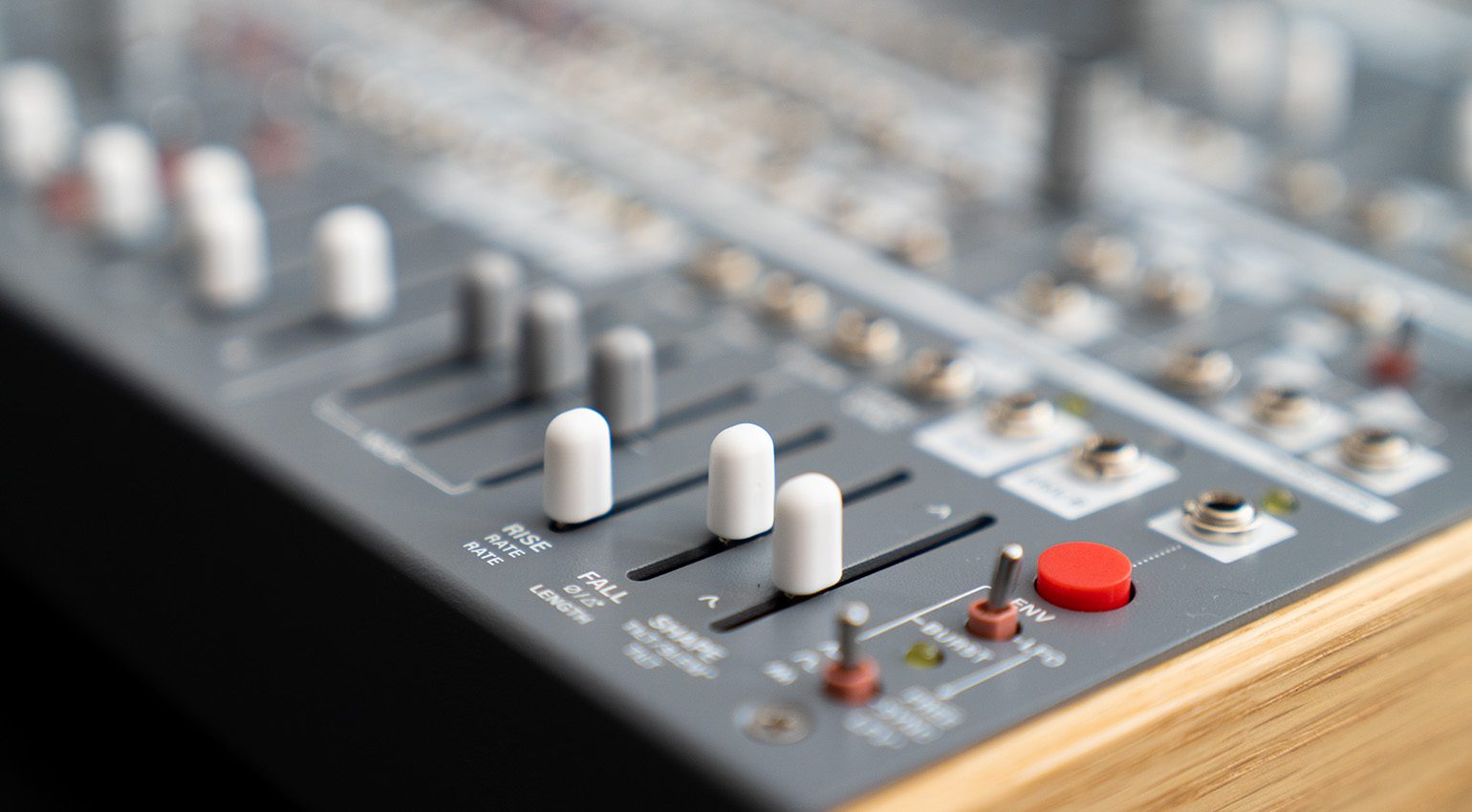
Endless sonic possiblities
Cascadia gives you East Coast synthesis and West Coast synthesis – at the same time. Buchla Easel meets Minimoog, Simple basses, 303-like sounds, leads, pads (monophonic or duophonic through detuning the second oscillator), dubby chords, drones, FM-sounds, disturbing soundscapes or endless envelope-triggered sequences – you name it. Everything is possible. If you combine Cascadia with a sequencer, the synth turns in to this beats of an electronic instrument where not just its pitch, but just about any sound parameter can be controlled and modulated.
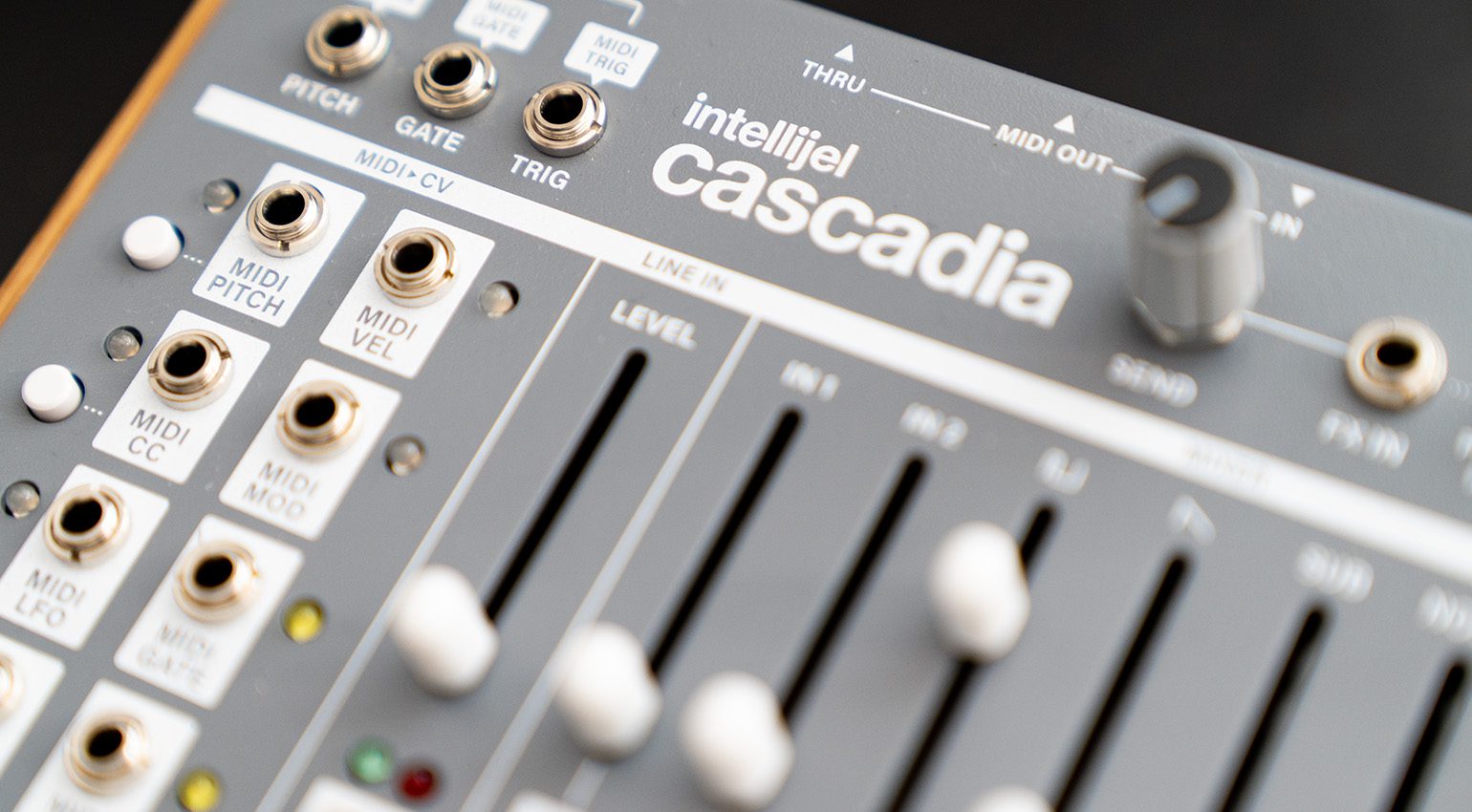
I’ve created a short video to demonstrate how to control Intellijel Cascadia with Ableton Push 3 standalone. I also added both Delay and Reverb to the synth’s output signal when I routed it back in to the Push. Sequencing, drum programming, additional sounds and mixdown all happened on the Push as well.
Conclusion
Intellijel Cascadia hit out of the park in almost every aspect. Its size and weight make it perfect for both crowded synth tables on stages and in overloaded studios. Casdcadia’s straight-forward signal path and routing is one if its biggest advantages. You just plug it in and start playing. And if you want to dive deeper and break open any parameter, the synth opens just about every door you knock on.
Despite all of its strength, all of its parameters, and connectivity, Cascadia is no jack-of-all-trades. There is no sequencer for once, and it wouldn’t have hurt to add at least a basic variety of internal effects like a reverb or a delay. And then there is the actual sonic character of the synth. You’re either going to love or hate, there is not much middle ground here.
Quality costs, and Cascadia is no exception. If you added up each individual modular in the instrument, you’d arrive at a much higher price (including the case). Just keep that in mind. Also, the synth allows both East Coast and West Coast sounds within one instrument, which is a rare feat. Overall, you get a very solid synthesizer equipped with great features and with endless sonic possibilities.

Intellijel Cascadia: price and features
Intellijel Cascadia is available at Thomann (Affiliate). You can get a variety of additional gear like a rack mount kit, metal side panels, and additional cables on Intellijel’s website.


The instrument’s weight is at 1.94 kilograms and it’s sized 348 x 246 x 66 mm. Cascadia includes 16 knobs, 34 faders, 101 patch points, 5 buttons, 36 LEDs as well as an on/off switch on the back. The package includes the instrument, an external power supply, a USB-C to USB-A cable, 14 patch cables ((4×10cm, 4×15cm, 4×30cm, 2×45cm), an Intellijel-branded cable tie, and a quick start guide.
For connectivity, you get jack outputs for audio, headphones, expression, a jack audio input, and a send and return, also jack. There is the power connection ( 15 V, 1 A), a USB-C port, and MIDI In/Out/Thru as well. The USB-C port can also be used for firmware updates.
More on the Intellijel Cascadia
- Cascadia website bei Intellijel
- More from Intellijel
Pros and Cons Intellijel Cascadia
Pros
- Compact and sturdy
- Plenty of inputs and outputs for extension
- great usability despite its small size
- Prefect internal setup to use it even without any patch cables
- Send/return for external effects
- Drive and two Soft Clip spots
- Integrated utility modules (Multiples, Mixuverter, Slew, Envelope Follower, Sum, Inverter)
Cons
- high price, but justified
- Sound could be more “particular”
- no integrated sequencer
Videos
Originally published on Gearnews.de by Marcus Schmahl. Translation by Julian Schmauch
*This post contains affiliate links and/or widgets. When you buy a product via our affiliate partner, we receive a small commission that helps support what we do. Don’t worry, you pay the same price. Thanks for your support!

 4,5 / 5,0 |
4,5 / 5,0 | 